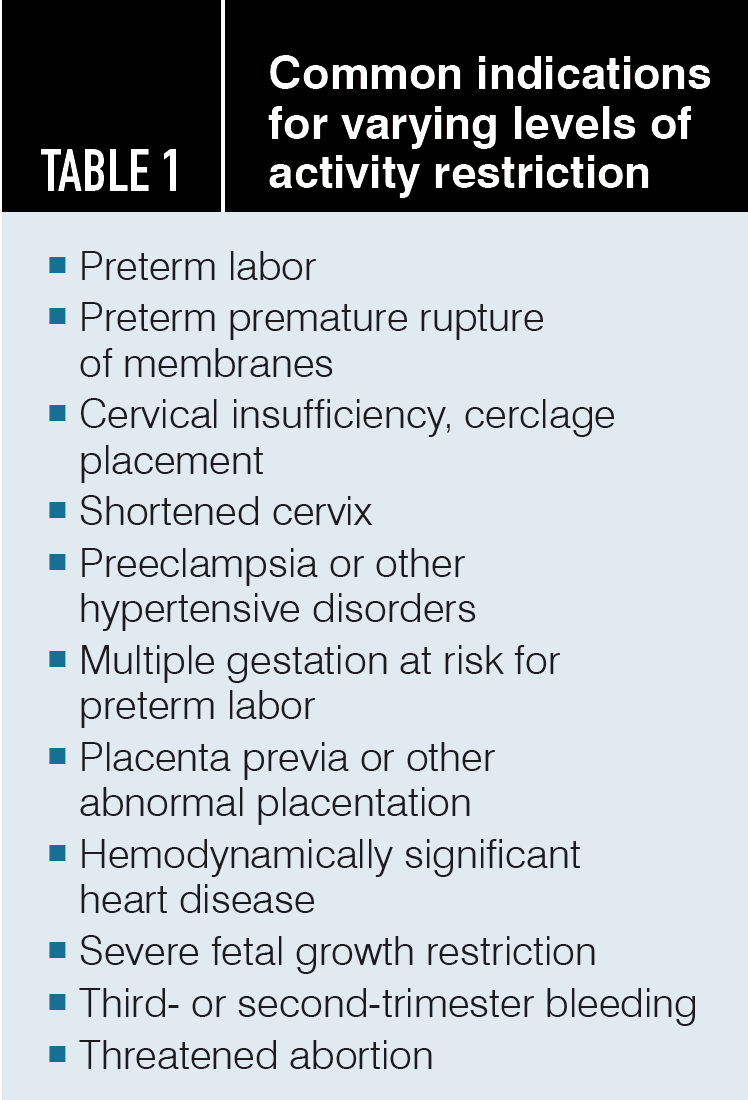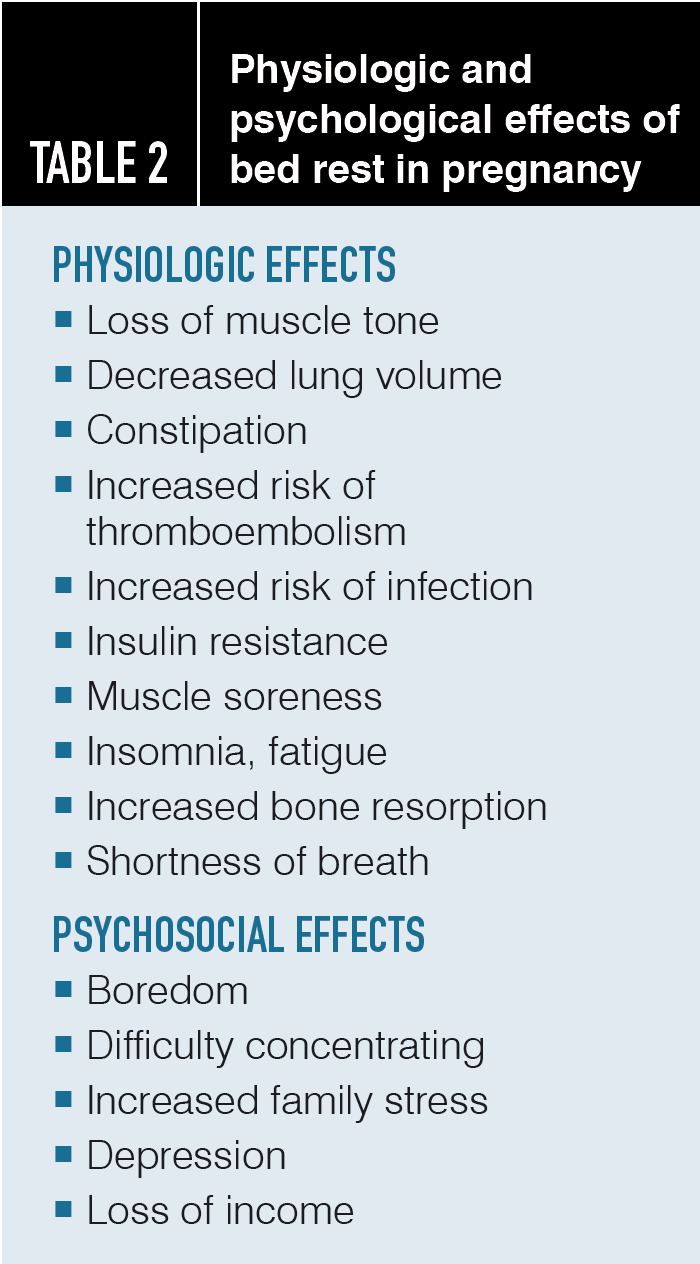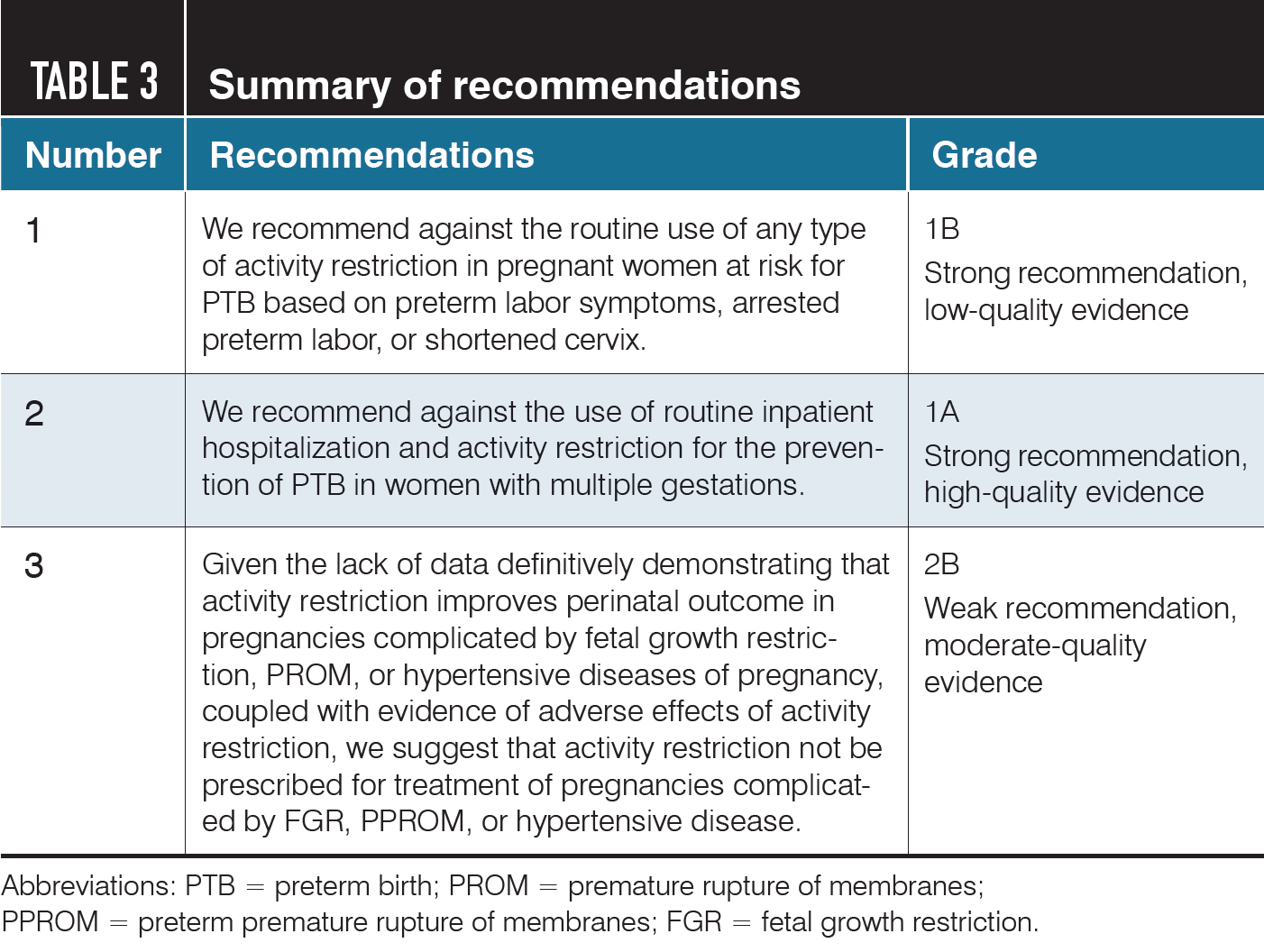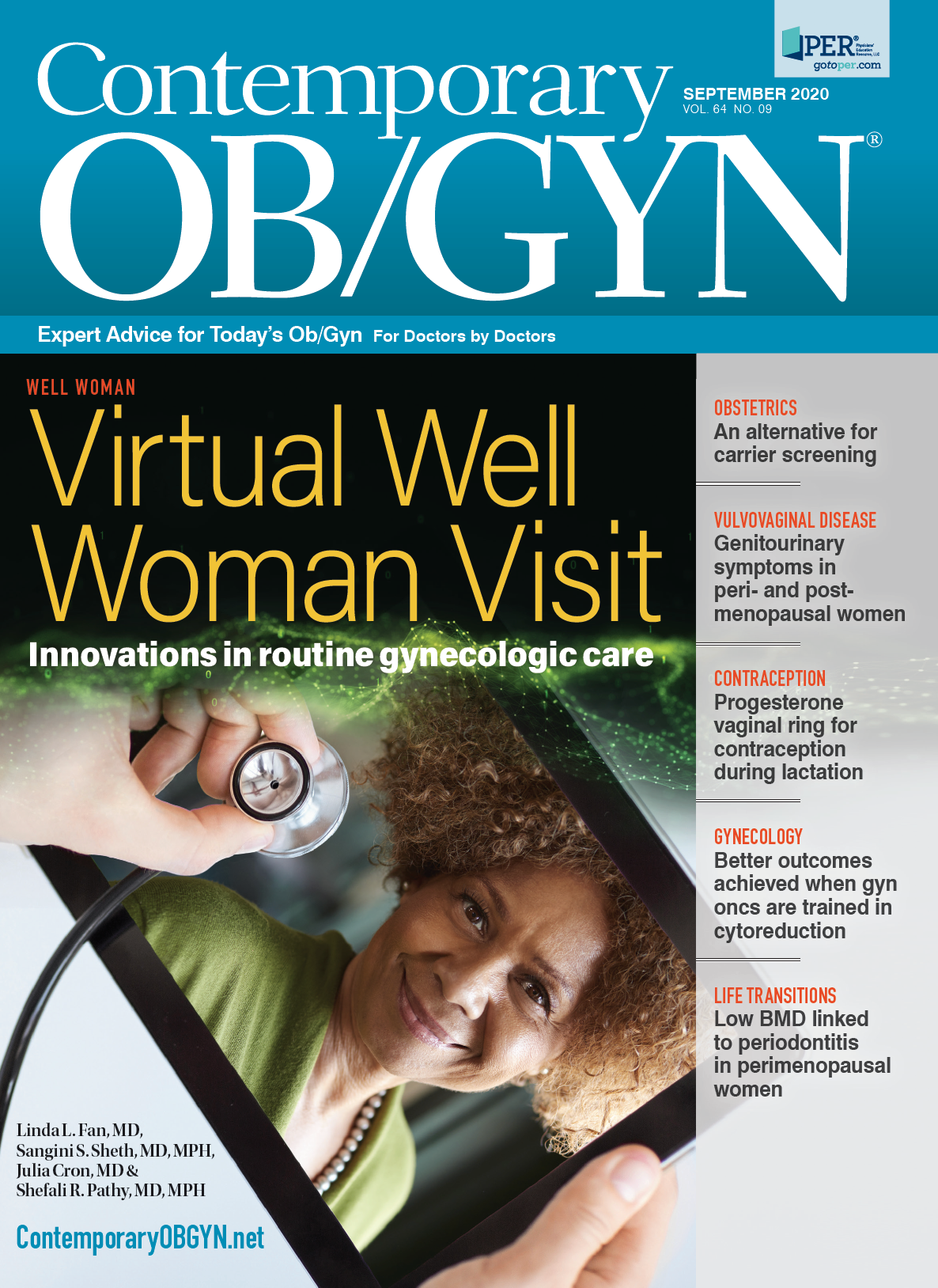Society for Maternal-Fetal Medicine Consult Series #50: The role of activity restriction in obstetric management
Little evidence supports the routine use of activity restriction for preterm birth and other obstetric conditions, and some data indicate adverse impact on obstetric outcomes.
Since the 1900s, based on the belief that activity restriction results in uterine quiescence and increased blood flow to the uterus, obstetrical care providers have recommended activity restriction to prevent preterm birth (PTB), and it remains a common intervention for PTB prevention in multiple clinical settings (Table 1).
Restriction of activity is also used in management of pregnancy complications such as preterm premature rupture of membranes (PPROM), gestational hypertension, preeclampsia, fetal growth restriction (FGR), placenta previa, threatened miscarriage, and complications of multiple gestations. Activity restriction has been prescribed in nearly 20% of all pregnancies at risk for PTB.1
Survey data from 2009 demonstrated that over 80% of maternal-fetal medicine subspecialists recommended activity restriction in women with cervical dilation, threatened preterm labor, and PPROM.2
A growing body of literature suggests that activity restriction fails to provide benefit, and in fact, confers significant physical and psychosocial risks for pregnant women, including deconditioning, inadequate maternal weight gain and lower infant birth weight, bone loss, increased risk of thromboembolic events, and significant financial costs and maternal stress.
The American College of Obstetricians and Gynecologists (ACOG) and other obstetric experts do not recommend the prescription of activity restriction and specifically "bed rest" for the prevention or treatment of preterm labor.3-6
Nevertheless, activity restriction continues to be commonly recommended by obstetricians and maternal-fetal medicine subspecialists.
What is the definition of activity restriction in pregnancy?
One of the difficulties in determining the benefits and harms associated with activity restriction is that no standard definition exists for this term. The terms "bed rest" and "activity restriction" are often used synonymously but may denote significantly different levels and intensity of activity. "Activity restriction" is typically used as a general term to describe some form of reduction in normal activity, while "bed rest" is usually considered the most restricted form of activity restriction.
Bed rest has been variously defined in research studies as limited ambulation of not more than 1 to 2 hours per day with bathroom use and bathing permitted4; confinement to bed with bathroom use permitted7; or resting three times a day for 1 hour.8
Additional restrictions of activity may include pelvic rest and cessation from exercise, heavy lifting, and employment. Pelvic rest has been variously defined as refraining from placement of anything in the vagina, with or without cessation of sexual intercourse and other sexual activities (such as orgasm).
In addition to the lack of a standard definition, there are no universally accepted objective measurements for activity restriction. Measures of activity restriction used in most studies are based on patient report in which subjects may be asked to keep a diary of their activity to quantify data.
The lack of objective measurements, such as heart rate or electronic activity monitoring, complicates the interpretation of research data and further limits the quality of available evidence.
What is the evidence regarding the benefits of activity restriction to prevent PTB in women with singleton pregnancies?
Two randomized clinical trials (RCTs) conducted by Elliott et al7 and Hobel et al8 found no differences in the rates of PTB in women who were prescribed activity restriction during pregnancy and those who were not prescribed this intervention. In addition to the lack of defined objective measurement of activity restriction, these two trials are limited by additional factors, including insufficient detail about methodology, absence of baseline characteristics of some of the study participants, and inclusion of both singleton and multiple gestations.
Some evidence suggests harm resulting from activity restriction. A secondary analysis of the Maternal-Fetal Medicine Unit (MFMU) Preterm Prediction Study9 found that women who were assessed as being at increased of PTB at 23 to 24 weeks of gestation and who were prescribed activity restriction were twice as likely to have a preterm delivery than those who were not prescribed activity restriction.
Study limitations included a lack of a consistent definition of activity restriction, absence of information regarding patient compliance with activity restriction, and the possibility that it was primarily the women at the highest risk for PTB who were prescribed activity restriction.
Table 1

In a secondary analysis of a trial of nulliparous women with singleton gestations and cervical length less than 30 mm who were randomized to treatment with 17-α hydroxyprogesterone caproate or placebo, Grobman and colleagues 20 found that PTB at less than 37 and less than 34 weeks of gestation was more common when women were placed on any type of activity restriction, whether inpatient or outpatient.
After controlling for potential confounders, they found an increase in the risk of delivery at less than 37 weeks of gestation and at less than 34 weeks of gestation (aOR 2.28, 95% CI 1.36–3.80) in women placed on activity restriction.10
A small pilot study used quantitative methods to study the effect of maternal activity on the rate of PTB.11 In this study, 49 pregnant women assessed as high risk for PTB wore a smart band activity tracker continuously for a week between 24 and 32 weeks of gestation.
The primary outcome was the rate of PTB at less than 37 weeks of gestation, and a secondary outcome was the rate of PTB at less than 34 weeks of gestation.
In all, 37 of the participants delivered preterm, and 12 delivered at 37 weeks of gestation or later. The median number of steps per day was significantly lower in participants who delivered preterm. In addition, regression analyses found an inverse association between the number of median steps per day and PTB.
In summary, although the evidence is limited and the quality generally low, available data do not demonstrate a benefit of activity restriction in women at risk for PTB, and some data suggest that this approach increases the risk of PTB.
We recommend against the routine use of activity restriction in pregnant women at risk for PTB based on preterm labor symptoms, arrested preterm labor, or shortened cervix. (GRADE 1B)
What is the evidence regarding the benefits of activity restriction in women with hypertension, PPROM, multiple gestations, and FGR?
In addition to prevention of PTB, management of hypertensive disorders of pregnancy, PPROM, multiple gestation, and FGR are common reasons for antepartum hospital admission and frequently lead to a recommendation for activity restriction.
With regard to hypertensive disorders, it has been hypothesized that activity restriction might result in a decrease in systolic blood pressure and an improvement in placental perfusion.
At present, the evidence regarding use of activity restriction for the prevention or management of hypertensive disorders in pregnancy is too limited to inform recommendations.
Women with PPROM are typically managed with inpatient admission and are also placed on activity restriction or bed rest in an attempt to prolong gestation and prevent umbilical cord prolapse. However, we identified no studies examining the effects of this practice on pregnancy outcomes.
Inpatient bed rest in mid- to late gestation was once recommended routinely for women with multiple gestations. A 2010 Cochrane review12 identified 7 RCTs that included 713 women assigned to routine inpatient bed rest versus hospitalization only if complications developed.
These trials did not demonstrate any difference in the rates of PTB or perinatal mortality. The only detectable benefit of hospital bed rest was a decrease in the number of neonates born weighing less than 2500 g.
A later Cochrane review in 201713 investigated the effect of strict bed rest (defined as resting in bed as much as possible with minimal physical activity) or partial bed rest (defined as rest for a few hours during the day with no other physical activity restrictions) in the hospital versus routine care on perinatal outcomes in women with a multiple gestation and found no differences in the risk of very PTB, perinatal mortality, low birth weight, small-for-gestational-age (SGA) infants, or PPROM.
Similar findings were noted for partial bed rest. While strict bed rest was associated with a higher mean birth weight, it was not associated with a decrease in SGA infants.
A few studies have examined maternal outcomes in women with multiple gestations on activity restriction, such as weight gain and indicators of mental health status. Maloni and colleagues found that maternal stressors, symptomatic side effects, and depressive symptoms were all increased, and maternal weight gain was suboptimal in patients placed on hospital bed rest.14
We recommend against the use of routine inpatient hospitalization and activity restriction for the prevention of PTB in women with multiple gestations. (GRADE 1A)
FGR is often attributed to placental insufficiency, and activity restriction or bed rest is often prescribed to improve placental perfusion.
However, a Cochrane review15 found only a single RCT that allocated women with growth-restricted fetuses to either bed rest in the hospital or work restriction at home (no subjects were allocated to normal activity). No differences were found in infant birth weight, Apgar scores, cord pH, or operative delivery rate.
Given the lack of data definitively demonstrating that activity restriction improves perinatal outcome in pregnancies complicated by FGR, PPROM, or hypertensive disease of pregnancy, coupled with evidence of adverse effects of activity restriction, we suggest that activity restriction not be prescribed for treatment of pregnancies complicated by FGR, PPROM, or hypertensive disease. (GRADE 2B)
What are the potential maternal risks of activity restriction?
Obstetric care providers frequently recommend activity restriction due to a perception that activity restriction has little associated harm. Studies in nonpregnant adults have revealed that clinically significant physiologic changes affecting multiple organ systems occur after only a few days of immobility (Table 2).2,5,16
In nonpregnant adults, lying supine during strict activity restriction shifts the position of the internal organs.
The abdominal viscera are displaced upwards against the diaphragm, which increases the effort required by the inspiratory muscles, decreases oxygen inspiration, and ultimately impairs gas exchange.
Furthermore, cardiovascular and physical deconditioning occur in addition to muscle atrophy and a prolonged decrease in cardiac output.
Table 2

Resumption of physical activity is often difficult and impaired. Following several weeks of bed rest, there is a decrease in metabolism and appetite, as well as skin breakdown, nerve compression, and shifts in hormone levels, including cortisol, thyroid hormone, and aldosterone.
Alterations in hormonal levels can affect sleep cycles and lead to insomnia and can also impair the function of the immune system.
Several studies in the pregnant population have reported similar adverse effects of prolonged inactivity. Pregnant women are also affected by physical deconditioning and loss of muscle mass.
One study examined muscle metabolism in the gastrocnemius muscle after prolonged antepartum inactivity and identified impairment of oxygenation indicative of deconditioning.17
Postpartum, women had protracted symptoms of deconditioning, including muscle soreness and impaired mobility. Similarly, inactivity in pregnancy has been shown to impair maternal weight gain. In one study, inadequate weight gain was correlated with low fetal birth weight across all gestational ages.18
RCTs are needed to compare women with high-risk pregnancies who are ambulatory with those on bed rest to analyze the extent to which bed rest, underlying maternal-fetal disease, or both contribute to inadequate maternal weight gain and poor intrauterine growth.
As in nonpregnant adults, prolonged inactivity in pregnant women is associated with negative effects on bone health. Studies of pregnant women treated with strict bed rest found an increased rate of trabecular bone loss19 and an increase in bone resorption markers, one of which continued to increase gradually over time and persisted into the postpartum period.20
Evidence suggests that inpatient activity restriction is associated with higher rates of gestational diabetes mellitus (GDM) among women admitted to the hospital for antepartum management of pregnancy-related complications.21
One retrospective study found that the risk of GDM increased by 4% for every day a pregnant woman remained on the inpatient unit. While data in pregnancy are limited, elevated blood glucose levels have been well documented in nonpregnant patients placed on activity restriction.16
Another serious concern with prolonged bed rest is the potential increased risk of thromboembolic events.
In general, inactivity increases the risk for venous thromboembolism (VTE), which is compounded by the hypercoagulable state of pregnancy. In one study, Kovacevich et al found a significant increase in the risk of thromboembolic events in pregnant women treated with bed rest lasting 3 days or more compared with those not on bed rest (15.6 cases per 1000 women vs 0.8 cases per 1000 women; P < .0015).1
What are the psychosocial effects of activity restriction?
Activity restriction in pregnancy can also cause significant emotional and psychological distress.
Compared with women with uncomplicated pregnancies, high-risk women on bed rest have more anxiety and depression. The negative psychosocial effects of bed rest are apparent with both inpatient and outpatient management, although hospitalized patients are known to have more sources of stress.
In particular, the extended time in bed can result in negative feelings, perseveration, and excessive worrying that can manifest as somatic symptoms. Women reported anxiety about the threat of losing their unborn child, guilt about separation from other children and loved ones, and concern for loss of employment or financial stability. The loss of wages can lead to significant financial concerns and is often a major source of stress for women.
Table 3

Many women who are placed on hospitalized bed rest express frustration and anger resulting from a lack of control or the perception that hospitalization confers minimal clinical benefit. Bed rest can also be associated with family disruption, leading to emotional stress for the spouse and other children. Separation from one's family has been shown to be the most significant stressor for some women.22
Social support from family, friends, and professionals is an important mediator of stress and depressive symptoms. Strain on these relationships compromises an important coping mechanism.
Summary
Little evidence supports the routine use of activity restriction for preterm birth and other obstetric conditions, and some data indicate adverse impact on obstetric outcomes. In addition, prolonged inactivity is associated with a variety of negative physiological and psychological effects (Table 3).
Given the lack of data definitively demonstrating that activity restriction improves perinatal outcome, coupled with evidence of adverse effects, we suggest that activity restriction should not routinely be prescribed.
For more on activity restriction, read Dr. Spong's editorial from the September issue of Contemporary OB/GYN, 'Putting activity restriction to rest.'
__
References
1. Kovacevich GJ, Gaich SA, Lavin JP, Hopkins MP, Crane SS, Stewart J, et al. The prevalence of thromboembolic events among women with extended bed rest prescribed as part of the treatment for premature labor or preterm premature rupture of membranes. Am J Obstet Gynecol. 2000 May;182(5):1089-92.
2. Sprague AE. The evolution of bed rest as a clinical intervention. J Obstet Gynecol Neonatal Nurs. 2004 Sep-Oct;33(5):542-9.
3. Sciscione AC. Maternal activity restriction and the prevention of preterm birth. Am J Obstet Gynecol. 2010 Mar;202(3):232 e1-5.
4. American College of Obstetricians and Gynecologists. Practice Bulletin No. 171: Management of Preterm Labor. Obstet Gynecol 2016 Oct;128(4):e155-64.
5. Maloni JA. Lack of evidence for prescription of antepartum bed rest. Expert Rev Obstet Gynecol. 2011 Jul 1;6(4):385-93.
6. McCarty-Singleton S, Sciscione AC. Maternal activity restriction in pregnancy and the prevention of preterm birth: an evidence-based review. Clin Obstet Gynecol. 2014 Sep;57(3):616-27.
7. Elliott JP, Miller HS, Coleman S, Rhea D, Abril D, Hallbauer K, et al. A randomized multicenter study to determine the efficacy of activity restriction for preterm labor management in patients testing negative for fetal fibronectin. J Perinatol. 2005 Oct;25(10):626-30.
8. Hobel CJ, Ross MG, Bemis RL, Bragonier JR, Nessim S, Sandhu M, et al. The West Los Angeles Preterm Birth Prevention Project. I. Program impact on high-risk women. Am J Obstet Gynecol. 1994 Jan;170(1 Pt 1):54-62.
9. Levin HI, Sciscione A, Ananth CV, Drassinower D, Obican SG, Wapner RJ. Activity restriction and risk of preterm delivery. J Matern Fetal Neonatal Med. 2018 Aug;31(16):2136-40.
10. Grobman WA, Gilbert SA, Iams JD, Spong CY, Saade G, Mercer BM, et al. Activity restriction among women with a short cervix. Obstet Gynecol. 2013 Jun;121(6):1181-6.
11. Zemet R, Schiff E, Manovitch Z, Cahan T, Yoeli-Ullman R, Brandt B, et al. Quantitative assessment of physical activity in pregnant women with sonographic short cervix and the risk for preterm delivery: A prospective pilot study. PLoS One. 2018;13(6):e0198949.
12. Crowther CA, Han S. Hospitalisation and bed rest for multiple pregnancy. Cochrane Database Syst Rev. 2010 Jul 7(7):Cd000110.
13. da Silva Lopes K, Takemoto Y, Ota E, Tanigaki S, Mori R. Bed rest with and without hospitalisation in multiple pregnancy for improving perinatal outcomes. Cochrane Database Syst Rev. 2017 Mar 6;3:Cd012031.
14. Maloni JA, Margevicius SP, Damato EG. Multiple gestation: side effects of antepartum bed rest. Biol Res Nurs. 2006 Oct;8(2):115-28.
15. Gulmezoglu AM, Hofmeyr GJ. Bed rest in hospital for suspected impaired fetal growth. Cochrane Database Syst Rev. 2000(2):Cd000034.
16. Greenleaf JE. Physiological responses to prolonged bed rest and fluid immersion in humans. J Appl Physiol Respir Environ Exerc Physiol. 1984 Sep;57(3):619-33.
17. Maloni JA, Schneider BS. Inactivity: symptoms associated with gastrocnemius muscle disuse during pregnancy. AACN Clin Issues. 2002 May;13(2):248-62.
18. Maloni JA, Alexander GR, Schluchter MD, Shah DM, Park S. Antepartum bed rest: maternal weight change and infant birth weight. Biol Res Nurs. 2004 Jan;5(3):177-86.
19. Promislow JH, Hertz-Picciotto I, Schramm M, Watt-Morse M, Anderson JJ. Bed rest and other determinants of bone loss during pregnancy. Am J Obstet Gynecol. 2004 Oct;191(4):1077-83.
20. Kaji T, Yasui T, Suto M, Mitani R, Morine M, Uemura H, et al. Effect of bed rest during pregnancy on bone turnover markers in pregnant and postpartum women. Bone. 2007 Apr;40(4):1088-94.
21. Merriam AA, Chichester KM, Patel KN, Hoffman KM. Bed rest and gestational diabetes: more reasons to get out of bed in the morning. Am J Obstet Gynecol. 2014;123:70S.
22. Maloni JA, Chance B, Zhang C, Cohen AW, Betts D, Gange SJ. Physical and psychosocial side effects of antepartum hospital bed rest. Nurs Res. 1993 Jul-Aug;42(4):197-203.

Study reports reduced maternal breastfeeding in late preterm infants
March 12th 2025A recent study reveals significantly lower initiation and continuation rates of Mother’s own milk feeding among late preterm infants compared to other gestational age groups, highlighting a need for targeted support.
Read More
S4E1: New RNA platform can predict pregnancy complications
February 11th 2022In this episode of Pap Talk, Contemporary OB/GYN® sat down with Maneesh Jain, CEO of Mirvie, and Michal Elovitz, MD, chief medical advisor at Mirvie, a new RNA platform that is able to predict pregnancy complications by revealing the biology of each pregnancy. They discussed recently published data regarding the platform's ability to predict preeclampsia and preterm birth.
Listen
